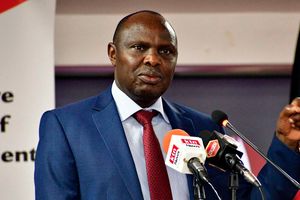State to spend Sh6bn on Form Ones, infrastructure

Students wait to be admitted to Elburgon Secondary School in Molo, Nakuru, on January 12, 2017. The government wants to increase the transition rate of pupils to secondary schools. PHOTO | JOHN NJOROGE
What you need to know:
- Dr Matiang’i said the government expected a 100 per cent transition to secondary school in 2018.
- The Office of the Auditor-General and the Directorate of School Audit will monitor and evaluate the use of the funds.
The transition of about 1.2 million Standard Eight pupils to secondary school next year will cost the government Sh6 billion, Education Cabinet Secretary Fred Matiang’i has said.
He added that the money will also be used to build 2,000 classrooms in 2,576 secondary schools.
“We shall also use the funds to construct 1,000 laboratories and 1,000 sanitation facilities,” Dr Matiang’i said and asked those involved to use the money responsibly and transparently.
CORRUPTION
The ministry has organised workshops in five centres to sensitise heads and boards of management whose schools are earmarked for expansion.
Dr Matiang’i said the government expected a 100 per cent transition to secondary school in 2018.
He added that the Office of the Auditor-General and the Directorate of School Audit will monitor and evaluate the use of the funds.
“Principals and boards should not agree to be influenced by lawmakers and other politicians on how to spend the infrastructure funds,” Dr Matiang’i warned.
He said some principals had complained that MPs demanded part of the money saying they had helped to secure the money for the schools.
QUALITY EDUCATION
The CS challenged the principals to adopt attitudes that will help promote discipline and a sense of purpose in the management of education.
“We have made mistakes in the management of education in the last one and half decade. Let’s return to the path of excellence in education.”
He decried the wastage of school resources, saying 57 per cent of resources meant for purchase of textbooks and other instructional materials did not get to schools.
He said the wastage had created a situation where the 1:1 pupil to textbook ration had not been attained in many schools, thereby denying students’ important item in quality learning.
CURRICULUM REVIEW
The CS said he had visited secondary schools where classrooms of over 40 students had less than 10 textbooks for subjects such chemistry and physics.
“There cannot be quality curriculum delivery with such few or no textbooks,” he explained during a forum with principals of secondary schools and chairpersons of Board of Managements at Nakuru Girls High School.
Director of Secondary Education, Robert Masese, said that sanitation facilities created positive environment for learners.





